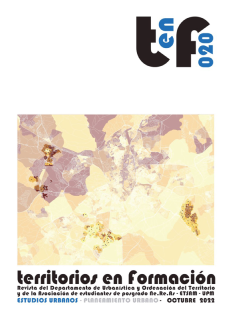Movilidad peatonal y “mezcla de usos”: una aproximación conceptual mediante el modelo de "la ciudad de distancias cortas” en Alemania = Pedestrian mobility and “mix of uses”: A conceptual approach using the "short distance city" model in Germany
DOI:
https://doi.org/10.20868/tf.2022.20.5142Palabras clave:
Movilidad peatonal, Usos de suelo mixtos, Ciudad de las distancias cortas, Movilidad sostenible, Diseño urbano Diversidad urbana, Walkability, Mixed land uses, The city of short distances, Sustainable mobility, Urban design, Urban diversityResumen
Resumen
El concepto “mezcla de usos” se ha convertido en un principio de planificación urbana clave en muchos de los actuales paradigmas de desarrollo urbano. Sin embargo, a pesar de su popularidad, el término permanece impreciso en su manera de entenderlo y aplicarlo. Este trabajo parte de la hipótesis de que, en el contexto alemán, la “mezcla de usos” está vinculada a la movilidad peatonal, siendo Alemania un referente de inclusión de esta variable en los planes de desarrollo urbano desde hace décadas, combinándolo con conceptos de movilidad sostenible basados en el modelo de “la ciudad de las distancias cortas”. A partir de una revisión sistemática se explora y analiza la comprensión de la variable “mezcla de usos”, se presentan tres ejemplos de aplicación y se concluye con una definición del concepto, su relación con la movilidad sostenible y peatonal y los elementos clave para su implementación.
Abstract
The concept of “mixed use” has become a key urban planning principle in many of today's urban development paradigms. Yet despite its popularity, the term remains vague in its understanding and application. This paper starts from the hypothesis that, in the German context, “mixed use” is strongly linked to pedestrian mobility, being Germany a reference where this variable has been included in urban development plans decades ago in combination with sustainable mobility concepts based on the model of "the city of short distances". Based on a systematic review, the understanding of the "mixed use" variable was explored and analyzed. Three examples of the application are presented. It’s concluded with a definition of the concept of “mixed use”, its relation to sustainable and pedestrian mobility and the key elements for its implementation in concrete projects.
Descargas
Referencias
Bundesamt für Bauwesen und Raumordnung (BBSR). (2011). Bund-Länder-Programm “Soziale Stadt”.
Bundesministerium für Verkehr, Bau- und Wohnungswesen.(2000). www.werkstatt-stadt.de. Innovative Beispiele aus dem Experimentellen Wohnungs- und Städtebau, Berlin.
Bretschneider, B.(2007) Nutzungsmischung: Ein Diskurs zu neuer Urbanität. Wien:
Brunsing, J. y Frehn, M (1999). Stadt der kurzen Wege. Zukunftsfähiges Leitbild oder planerische Utopie? Dortmund: Blaue Reihe Dortmunder Beiträge zur Raumplanung
Charter of European Cities & Town Towards Sustainability. (1994) Aalborg.1994
Charter of the Sustainable European Cities, (2007), Leipzig.
Campoli, J. (2012) Made for Walking. New Hampshire: Lincoln Institute of Land Policy.
Cervero, R. (1989) Jobs-Housing Balancing and Regional Mobility. Journal of the American Planning Association, 55, 136-150.
Cervero, R., Kockelman, K. (1997). Travel Demand and the 3DS: Density, Diversity, and Design. Transportation Research Part D: Transport and Environment, 2, 199-219. http://dx.doi.org/10.1016/S1361-9209(97)00009-6
Ewing, R., Nelson, A. Y Bartholomew, K. (2009). Response to special Report 298, Driving and the built environment: The effects of compact development on motorized travel, energy use, and CO2 emissions. Salt Lake City: Metropolitan Research Center, University of Utah.
Feldtkeller, A. Die zweckentfremdete Stadt: Wider die Zerstörung des öffentlichen Raums
Frehn, M. y Holz-Rau, C. (1999) In kleinen Schritten zu kurzen Wege. Von den Zweifeln zur Umsetzung einer “Stadt der kurzen Wege”. Dortmund: Dortmunder Beiträge zur Raumplanung. 1999
Gertz, C. (1998). Umsetzungsprozesse in der Stadt- und Verkehrsplanung. Die Strategie der kurzen Wegen. Berlin: Technische Universität Berlin.
Georg, G. y Philip, G. HILIP Graze (2007) Raus aus Suburbia, rein in die Stadt? Studie zur künftigen Wohnmobilität von Suburbaniten der Generation 50+. Raumforschung und Raumordnung, Jg. 65, Heft 5, S. 467–473.
Hass-Klau, C. (2015). The Pedestrian and the City. New York.
Heineberg, H. (2001) Grundriss Allgemeine Geographie. Stadtgeographie. (2ª ed.) Paderborn.
Heinrichs, D. y Jarass, J. (2020). Alltagsmobilität in Städten gesund gestalten: wie Stadtplanung Fuß- und Radverkehr fördern kann
Hess, S. (2015). Das Tübinger Modell als städtebauliches Leitbild. Das Französische Viertel in Tübingen
Hirt, S. (2010). To zone or not to zone. Comparing European and American Land-use Regulation.
Holzapfel, H. (2007). Urbanismus und Verkehr. Wiesbaden:
Holz-Rau C, Scheiner J (2005) Siedlungsstrukturen und Verkehr: Was ist Ursache, was ist Wirkung? Raumplanung 119:67–72
Jacobs, J. (1967). Muerte y vida de las grandes ciudades. Madrid: Ediciones Península.
Kemper, F., Kulke, E. y Schulz, M. (2012). Die Stadt der kurzen Wege. Berlin.
Klühspies, J. Stadt der kurzen Wege - Abstract. Consultado en internet. http://kluehspies.de/index.php?de_city_shortways_abstract. Acceso 11.2017
Kögler, N. (2011). Das Leitbild der “Stadt der kurzen Wege in Potsdam-Im Spannungsfeld zwischen Idee und Konkretisierung. Norderstedt.
Lamíquiz, F. (2011). The implications of configurational accessibility in pedestrian mobility. The case of Madrid. PhD Thesis Universidad Politécnica de Madrid.
Maerletto, G. (2016) Freiburg: From ‘Auto-City’ to ‘City of Short Distances’ (1945–2010)
Sanbancilar, S. (2002) Nachhaltige Stadtentwicklung. Beitrag eines Leitbildes zur Verbesserung der Lebensqualität. Berlin.
Siebel, W. (2005) Was ist eine europäische Stadt? EuropaKulturStadt. Beilage des Deutschen Kulturrates und der Kulturstiftung des Bundes in Politik und Kultur, Nr. II, S. 1–2 .
Sieber, N. (2000) Durch Raumplanung Verkehr vermeiden in Verkehr in Stadt un Region. Leitbilder, Konzepte und Instrumente. Hannover.
Strawe, C. (2017). Arbeitszeit, Sozialzeit, Freizeit - Ein Beitrag zur Überwindung der Arbeitslosigkeit. Institut für soziale Dreigliederung. https://www.dreigliederung.de/essays/1994-12-001. Acceso 11.2017
Reichow, H. (1959). Die Autogerechte Stadt. Ravensburg.
Roskamm, N.(2013). Das Leitbild von der “Urbanen Mischung”, Studie für die IBA, Berlin.
Stadt Heidelberg (2015) Bahnstadt - von der Idee zur Umsetzung.
Stadt Freiburg (2023). Quartier Vauban. https://www.freiburg.de/pb/site/Freiburg/get/params_E-1604864046/647919/Infotafeln_Vauban_en.pdf. Acceso Febero 2023.
Stadt Leipzig (2015). Stadtentwicklungsplan Verkehr und öffentlicher Raum. https://static. leipzig.de/fileadmin/mediendatenbank/leipzig- de/Stadt/02.6_Dez6_Stadtentwicklung_Bau/66_ Verkehrs_und_Tiefbauamt/StEP/StEP_Verkehr. pdf. Acceso Mayo 2022.
Topp,H.H (1997). Die Stadt der kurzen Wege - der attraktive Standort.
Umwelt und Verkehr: Beitrage für eine Nachhaltige Politik / Hermann Schaufler.
Umweltbundesamt (2011). Leitkonzept Stadt und Region der Kurzen Wege. Gutachten im Kontext der Biodiversitätsstrategie. 2011
Páginas web:
http://www.heidelberg.de, acceso 01.12.2016
https://www.autofrei-verein.de/der-verein/der-verein, acceso 02.02.2023









